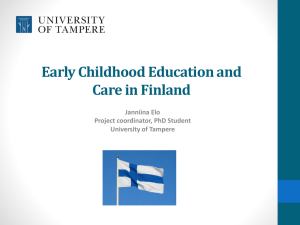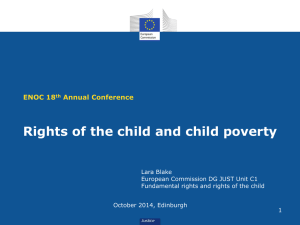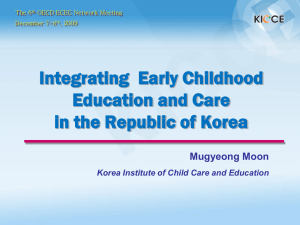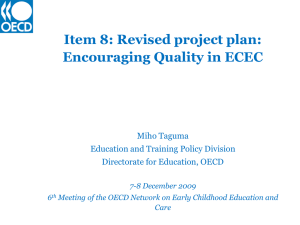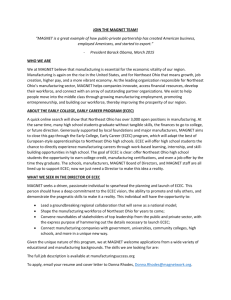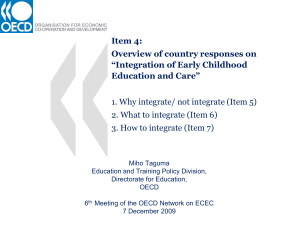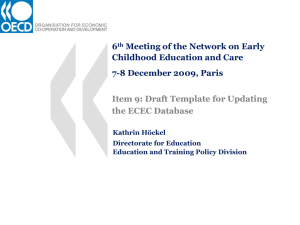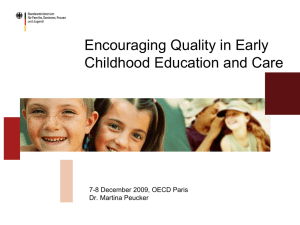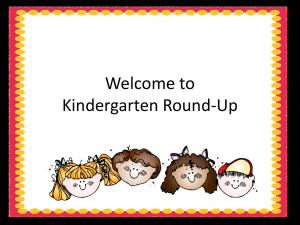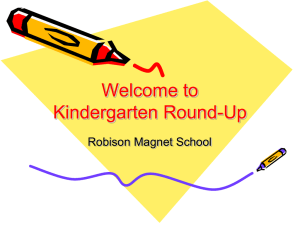FINLAND_What_we_can_learn
advertisement
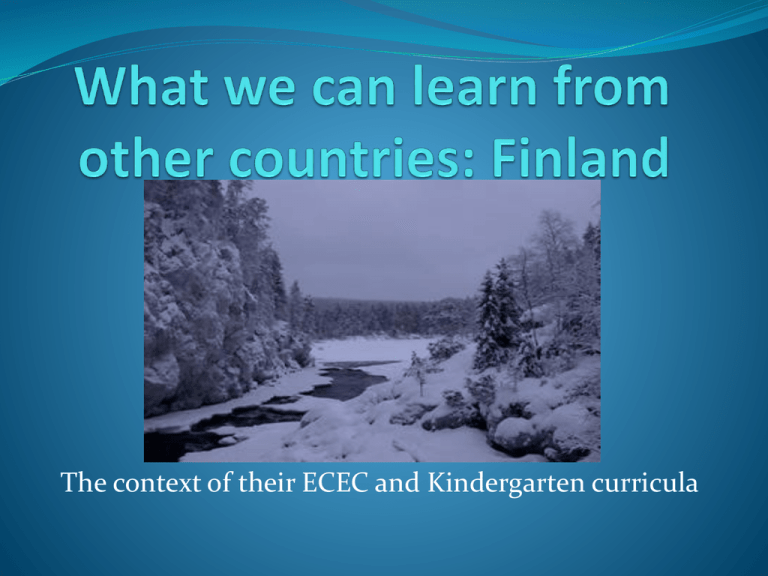
The context of their ECEC and Kindergarten curricula POPULATION 5.3 Million Average density 17 per sq km. Most sparse in EU Current life expectancy: men 76.3, women 83.0 years Average household 2.1 persons 55% of households in single family homes and 45% in apartment blocks Low perinatal mortality TFR 1.7 Languages 91% Finnish (an Ugric language: Suomi) 5.4% Swedish Finland is bilingual by legislation and custom English widely spoken Sami languages (Lap) in the north (Sami) Religion 81% are Lutheran, yet Lutheranism seems to sit lightly on their pagan past 1% Orthodox A republic with no official ties to monarch or church Education 78% of population have completed upper secondary or tertiary education 35% have university or other similar qualifications (Highest in EU) Repeatedly top in PISA studies Highest percentage literacy in the OECD All education, including university, is free Childcare free, or means tested, till age 7 State comprehensive school 7 to 18 years Education (cont) Reverence for education Kindergarten teachers very well trained, often with higher grade averages than lawyers or medics. Frequently with MAs School meals for all, free, since 1950s No real private education, though specialist groups exist No official curriculum until age seven, though broad guidelines of principle for ECEC and also for Kindergarten Much child choice and many project approaches to early learning. Childcare usually ‘integrated’ Playtime Government Sovereign parliamentary republic since 1917 Part of the Russian empire from 1809-1917 and before that part of Sweden for centuries President elected every six years Tarja Halonen, female, elected for second term in 2006 200 members of parliament elected every 4 years; several parties, coalition usual. Member of EU since 1995 Finnish working life 85.3% of women employed outside the home Unemployment rate 8% Generous social support Free medical treatment (high standard) High taxes, base tax 52% High standard of living Per capita GDP in top four OECD countries Annual inflation rate (2009) -0.5% Economy GDP, 2008 was 187.0 billion Euros 25% of exports are electronic and optical 21% are wood and pulp products 25% machinery and metal products Germany, Russia, Sweden, UK and USA take bulk of exports Area, geography, miscellaneous One third of country above the Arctic Circle 9% lakes of fresh water 6% of land under cultivation 68% of the country in forests Capital is Helsinki (1 million) Five other major cities 99% of families have cell phones 75% have personal computer Bears and wolves and reindeer in north The northernmost university in the world, Lapland, Rovaniemi ECEC and Pre-primary (Kindergarten) Social policy is the frame for early years education All 6-7 yr old Finns entitled to free Kindergarten This can be in day-care, 1 to 7yrs, or in school. 6 to 18. Parents choose where for under sevens; 80+% opt for day care (age six to seven) 50% of children in day care ; 40% at home (special allowances) 4% private, but paid for (figures approx) Private day care is where parents organise it themselves. They have to act like state day care. Municipal day care organised by local authorities. Day care (cont) Child home care attracts an allowance of 295 Euros pm(2008) and the allowance is part of maternity/paternity benefit. Usually it is accessed in the child’s first year and the child then goes full or part-time (choice) to day care. (approx a third go parttime up to 6yrs) STAFF are multidisciplinary because it is ECEC One third of staff have degrees including Master’s degrees. New (2008) regs insist ALL have special lengthy vocational training. Many also with Polytechnic degrees The road to school, Rovaniemi The road to school near Oulu Adult:child ratios; Finance; SN Basic ratio is one adult to seven children (age 3-6) 0-3 is one adult to four children Family Day Care 4-5 children per adult Government and Municipalities (400 plus) jointly finance Day care, with parental fees (means-tested) topping up costs Special Needs 80%+ integration; about 10%+ special schools and/or classes. Currently under review. ECEC Principles and guidance 1 The Prime Goals of the national curriculum for ECEC are: 1. The promotion of personal well-being 2. Reinforcement of considerate behaviour and action towards others 3. The gradual building of autonomy and self-efficacy The guidance states that children learn best when they are active and through playing, moving, exploring. Each Municipality has to write curriculum guidelines which fit the national ones and these are then incorporated in the centre’s own curriculum planning. ECEC Principles and guidance 2 Content is not DEFINED, since there are (as the Finns say) NO LISTS OF RIGHT ACTION. However, there is an expectation that key constructs developed through maths, natural sciences, aesthetics, religions and philosophy will be incorporated in projects, such that they can be continued meaningfully in the more precise Kindergarten (preschool) curriculum which follows at 6 years. Pre-school age 6 to 7 Finnish six year olds have a right to free half day pre school curricula. (Majority do this in Childcare or ‘Kindergarten’, as it is called. Only 10% do it in school, 97.8% receive it.) The curriculum is the national Core Curriculum for Pre-School and is aligned with School Curriculum. It is heavily process oriented and ‘developmental’ in its approach, utilising project methodology and a high degree of child choice. Language, oracy and communication have a central role in the pre-school curriculum. Methods are not prescriptive and individual child plans are central. Preschool education generally Provided in every municipality for 700 hours per year. Administered by the Ministry of Education Since 2004 the curriculum activities(very general) have been included in the Basic Education Act. When the group size exceeds 13 to a fully qualified teacher , there must be an assistant with at least upper secondary and vocational training. Parents fully recognised as major partners in ECEC and Pre-school.
